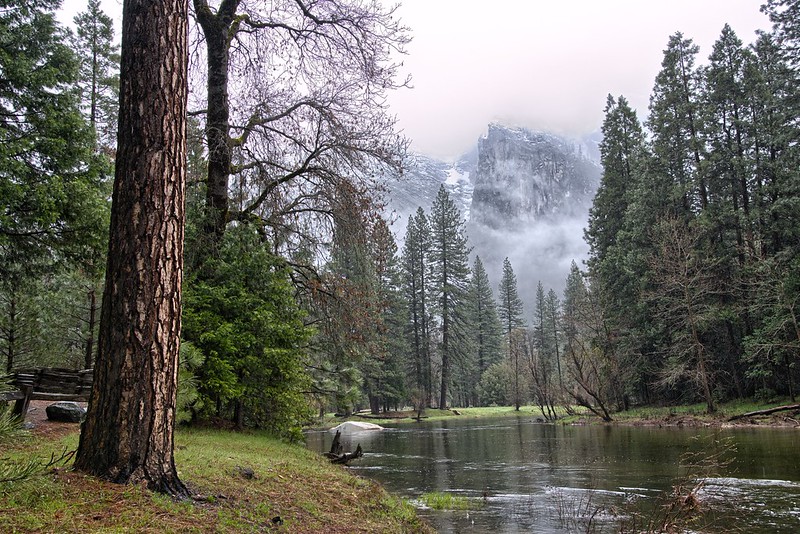Welcome to Yosemite Park, where the majestic beauty of nature dominates and creates a canvas of spectacular scenery. In this trip, we explore Yosemite Valley Floor, a refuge of natural wonders that entices both explorers and nature lovers.
Our tour starts in Yosemite Valley’s center, where a confluence of breathtaking vistas and unforgettable experiences awaits. Each stop promises a distinctive aspect of Yosemite’s magnificence, from the ethnic diversity of Yosemite Village and the compelling artwork at the Ansel Adams Gallery to the vast beauty of Tuolumne Meadows and the exciting heights of High Country.
Catch peeks of the far-reaching panoramic views from Olmsted Point as we travel the famous Tioga Road. Discover the ancient giants of Wawona and Mariposa Grove, find peace in the Tuolumne meadows, and explore Yosemite National Forest’s pure beauty.
Explore the ecological delights of Mono Lake, where nature’s beauties continue to enchant, to continue our voyage. So lace up your hiking boots, grab your sense of wonder, and come along as we explore the wonders that adorn the Yosemite Valley Floor and invite you to experience the unmatched splendor of this natural refuge.

Yosemite Valley Floor
Yosemite Valley Floor is a huge, flat area in Yosemite National Park’s centre. Many of the park’s most prominent attractions are located here, including Yosemite Falls, Half Dome, El Capitan, and Bridalveil Fall.
The valley floor stretches for around 7 miles and is 3 miles broad. It is surrounded by 3,000-foot-high granite cliffs that rise from the valley floor.
A wide range of plant and animal species can be found on the valley floor. Pines, firs, oaks, and meadows are among the common vegetation found in the valley. Deer, bears, coyotes, and squirrels are among the numerous creatures.
Hiking, camping, fishing, and sightseeing are common activities on the valley level.
Here are some activities available on the Yosemite Valley Floor:
-
- Hike to Yosemite Falls, North America’s tallest waterfall.
- Climb Half Dome, one of the world’s most recognisable granite faces.
- Visit El Capitan, the world’s largest granite monolith.
- Bridalveil Fall, a 620-foot waterfall cascading over granite cliffs, is a must-see.
- Swim in the Merced River that runs through the valley.
- Visit the Yosemite Valley Visitor Centre, which offers displays on the valley’s history and geology.
Yosemite Village and Museum and Ansel Adams Gallery
Yosemite Village is the main activity centre of Yosemite National Park. It is in the middle of Yosemite Valley and houses a number of hotels, restaurants, stores, and attractions. Yosemite Village is an excellent spot to stay if you are visiting Yosemite National Park. It is conveniently placed and equipped with everything you need to make your stay enjoyable.
The Yosemite Museum, located in Yosemite Village, features displays on the park’s history, geology, and natural history.
The Ansel Adams Gallery, also in Yosemite Village, sells Ansel Adams images as well as books, prints, and other gifts. The Yosemite Museum and Ansel Adams Gallery are also worth a visit if you are interested in learning more about the park’s history and natural beauty.
Tuolumne Meadows and High Country
Tuolumne Meadows is a huge subalpine meadow in Yosemite National Park’s eastern section. Lembert Dome, Tuolumne Dome, and Clouds Rest are among the granite domes that surround it. Meadows, pines, firs, wildflowers, deer, bears, and marmots are among the plant and animal species found in the meadows. Tuolumne Meadows is a popular hiking, camping, fishing, and tourist location. There are also other paths that lead to the park’s high country, which is a more lonely and difficult location.
High Country refers to the portion of Yosemite National Park above 9,000 feet in height. It is a large and rugged terrain with several lakes, rivers, and peaks.
The high country is popular with skilled hikers, backpackers, and climbers. There are also several routes that lead to breathtaking views, such as Olmsted Point and Tioga Pass.
Tioga Road
Tioga Road is a picturesque highway that travels from west to east through Yosemite National Park. Tioga Pass is the highest highway pass in California, reaching an elevation of 9,945 feet.
The road was created in the 1880s as a mining route, although it was not open to the public until 1961.
It is a renowned tourist and photography site. The vistas of the Sierra Nevada mountains, especially Half Dome, Glacier Point, and Yosemite Valley, are breathtaking. The road is also popular with hikers, bikers, and campers. Tioga Road is the starting or ending point for a variety of trails, including the John Muir Trail and the Pacific Crest Trail. It is usually accessible from late May or early June to November, depending on the weather. Before you leave, check the road conditions.
Olmsted Point
Olmsted Point is a picturesque overlook in Yosemite National Park located on Tioga Road. It provides panoramic views of the Sierra Nevada mountains, including Half Dome, Clouds Rest, and Tenaya Lake. The point is named after Frederick Law Olmsted, who designed Central Park in New York City. Olmsted Point is a renowned tourist and photography site. The vistas are extremely magnificent and are only a short walk from the parking area.
When the light is optimal, the best times to visit Olmsted Point are early in the morning or late in the afternoon. The Tenaya Lake Loop and the Clouds Rest Trail are two routes that begin at Olmsted Point.
Tuolumne Meadows
Tuolumne Meadows is a huge subalpine meadow in Yosemite National Park’s eastern section. Lembert Dome, Tuolumne Dome, and Clouds Rest are among the granite domes that surround it. Meadows, pines, firs, wildflowers, deer, bears, and marmots are among the plant and animal species found in the meadows.
Tuolumne Meadows is a popular hiking, camping, fishing, and tourist location. There are also other paths that lead to the park’s high country, which is a more lonely and difficult location.
Wawona and Mariposa Grove
Wawona is a tiny town in Yosemite National Park’s southern section. It is the site of the historic Big Trees Lodge, as well as a number of cabins and a campground. Mariposa Grove, one of the world’s largest groves of enormous sequoia trees, is also located in the Wawona area.
The Mariposa Grove was discovered by non-natives Galen Clark and Milton Mann in 1857. The grove was called after Mariposa County, California, where it is located. The forest has Several hundred mature giant sequoia trees, including the Grizzly Giant, Fallen Monarch, and Wawona Tunnel Tree. The Mariposa Grove is a popular hiking, camping, and tourist attraction. The Grizzly Giant Loop Trail and the Fallen Monarch Loop Trail are two of the routes that go through the grove.
Yosemite National Forest
Yosemite National Park is a vast mountainous area in California’s Sierra Nevada mountains. It has soaring granite cliffs, wide valleys, massive sequoia forests, and beautiful streams. The forest also supports a diverse range of species, including black bears, deer, and coyotes.
Yosemite National Forest, founded in 1890, is one of the most visited national forests in the United States. Every year, about 4 million people visit the forest.
Hiking, camping, fishing, and rock climbing are just a few of the activities available in Yosemite National Forest. The forest also has some historical landmarks, such as the Mariposa Grove of Giant Sequoia Trees.
Mono Lake
Lake is a salty lake located in Mono County, California, approximately 22 miles (35 kilometres) east of Yosemite National Park. It is one of the oldest lakes in North America, dating back over a million years. The lake has no exit to the ocean since it is endorheic. This means that the lake’s water evaporates, leaving salts and minerals behind. As a result, Mono Lake is extremely salty, roughly 2.5 times saltier than the ocean.
Mono Lake has a distinct environment. The lake’s high salinity makes it impossible for most plants and animals to survive. However, a few species, such as brine shrimp, alkali flies, and white pelicans, have adapted to the extreme environment.
Mono Lake is a major tourist site as well. Visitors come to enjoy the lake’s natural beauty as well as to hike, camp and birdwatch.
Here are some of the activities available at Mono Lake:
Hike: Around Mono Lake, there are various hiking paths, including the South Tufa Trail, the Mono Lake Tufa State Reserve Trail, and the June Lake Loop.
Campgrounds: The Mono Lake Campground, Gull Point Campground, and Paoha Island Campground are all located near Mono Lake.
Birdwatching: With over 300 kinds of birds in the region, Mono Lake is an excellent spot for birdwatching. White pelicans, eared grebes, and gulls are among the most common birds to witness.
Visit the Mono Lake Tufa State Reserve: The Mono Lake Tufa State Reserve is a protected area that preserves Mono Lake’s distinctive tufa formations. The reserve has many hiking paths as well as an educational centre.
Take a boat tour: Several businesses provide boat tours of Mono Lake. These cruises are an excellent way to appreciate the lake’s distinct beauty up close.

Viswanath Alikonda (Viswa) is a techie, passionate traveler, writer, and adventurer who believes that life is best experienced through the exploration of new places and cultures. With a deep love for adventure and a curiosity that knows no bounds, Viswa has embarked on journeys to various corners of the globe, from the New York to Bay Area.
His travel experiences have not only broadened his horizons but have also given him the opportunity to share stories, insights, and travel tips with a global audience. Viswa’s travel blogs aim to inspire fellow wanderers, offering a glimpse into the beauty of our world and providing practical advice for planning unforgettable adventures.
